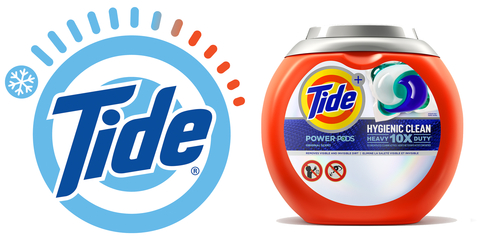Tide and World Wildlife Fund Join Forces to Encourage Next Impactful Eco-Habit: Washing in Cold
Tide and the World Wildlife Fund (WWF) have partnered to promote washing laundry in cold water, saving up to 90% energy and approximately $150 annually for consumers. This initiative aims to shift 3 in 4 laundry loads to cold by 2030, significantly impacting climate change. If successful, this switch could cut GHG emissions by 27 million metric tons over a decade. Currently, over 50% of laundry is done in cold water, highlighting progress toward this goal. Tide’s sustainability efforts are crucial, addressing both eco-habits and consumer behavior to create a lasting impact.
- Partnership with WWF to promote cold water washing supports sustainability and energy-saving habits.
- Potential savings of $150 annually for consumers switching to cold water, enhancing brand appeal.
- Tide's goal to increase cold water use to 75% by 2030 aligns with climate change efforts.
- Current adoption rate of cold water washing is over 50%, showcasing strong consumer interest.
- None.
America’s #1 trusted detergent and world’s leading conservation organization launch initiative to study and drive sustainable consumer behavior change
Tide and

(Photo: Business Wire)
To raise awareness of the next impactful, energy-saving eco-habit and drive adoption of cold water wash at scale, Tide and WWF will conduct new research to better understand behavioral tipping points, including the significance of cues at the point of action in the laundry room. The goal is to use this new research to inform increasingly impactful behavior change campaigns in the race against the clock to limit the warming of the planet to 1.5 degrees by 2030.
The Big Benefits of a Simple Switch
Consumer behavior, when accompanied by infrastructure, political, and manufacturing changes has the potential to make a meaningful impact toward climate change. The potential environmental impact of Americans turning to cold water is so significant that, last year, Tide set a goal to turn 3 in 4 laundry loads to cold by 2030 as part of a series of overarching environmental ambitions.
Tide estimates that a decade of Americans washing the majority (3 in 4) of their loads in cold would save enough electricity to power all of
Currently, more than half of laundry loads are done using cold water. This puts Tide roughly a quarter of the way to its 2030 cold water ambition in the first year, thanks in large part to multiple, broad-reaching brand marketing campaigns touting the benefits of cold water in the last twelve months.
“Advancing cold water adoption is our single greatest opportunity as a brand to drive positive impact for our planet, given that over two-thirds of the impact of laundry comes from the energy required to heat water in the wash cycle,” said
As America’s most trusted laundry detergent, Tide has led the charge to switch to cold water washing for more than 20 years with breakthrough innovations like enzymes specifically optimized for performance in lower wash temperatures. Efforts to drive cold water adoption were advanced by the announcement of Tide’s 2030 Ambition last March, a set of broad-reaching sustainability commitments to decarbonize laundry and reduce GHG emissions across the entire laundry lifecycle, including a goal to cut GHG emissions by half in Tide’s manufacturing operations.
Working to Speed Behavior Change
The urgency of climate change requires us all to continually adopt new, individual habits that, taken together again and again over time, have considerable positive impact for the planet. Consumers want to do their part to live more sustainably at home (
According to a survey by Tide and WWF, turning off the lights is broadly recognized by Americans as an important eco-habit (
“We have seen how the accumulation of small acts can lead to big impact. With the window for reaching our climate goals rapidly closing, it is imperative that we demonstrate in big and small ways our commitment to protect our planet for today’s inhabitants and future generations,” said
Tide and WWF are collaborating on new research to uncover insights on behavioral tipping points -- specifically, the importance of physical cues at the point of consumer action in the laundry room. The research project will build on existing studies Tide has conducted that show that when consumers hear about the numerous benefits of cleaning in cold, they convert. For example, while nearly 70 percent of people still use either warm/or hot water to some degree when washing, over 60 percent would wash on cold if they knew it could help the environment. Moreover, when consumers do try washing in cold, they are likely to keep the habit, citing brighter whites and colors, better clothing longevity and a sense of personal accomplishment knowing they have made an environmentally friendly choice8.
For more information about cold water washing and Tide’s collaboration with WWF, please visit tide.com.
About
P&G serves consumers around the world with one of the strongest portfolios of trusted, quality, leadership brands, including Always®, Ambi Pur®, Ariel®, Bounty®, Charmin®, Crest®, Dawn®, Downy®, Fairy®, Febreze®, Gain®, Gillette®, Head & Shoulders®, Lenor®, Olay®, Oral-B®, Pampers®, Pantene®, SK-II®, Tide®, Vicks®, and Whisper®. The P&G community includes operations in approximately 70 countries worldwide. Please visit http://www.pg.com for the latest news and information about P&G and its brands. For other P&G news, visit us at www.pg.com/news.
1 On average, when switching from hot to cold water
2 Based on average American household electricity consumption, as reported by the U.S.
3 According to reported city-wide annual electricity usage by
4 Over the decade, 2020-2030
5 As outlined in P&G’s Climate Action Transition Plan
6 Based on 2021 P&G “It’s Our Home” study
7Based on 2022 Tide consumer study
8 Based on 2021 Tide consumer study
View source version on businesswire.com: https://www.businesswire.com/news/home/20220421005216/en/
molski.hd@pg.com
Chloe Kivestu
chloe.kivestu@ketchum.com
Source:
FAQ
What is the partnership between Tide and WWF about?
How much energy can be saved by washing clothes in cold water?
What are Tide's goals for cold water washing by 2030?
What financial benefits do consumers gain from using cold water for laundry?







